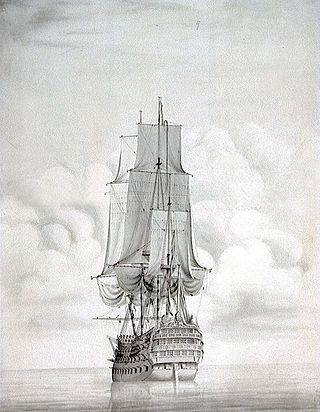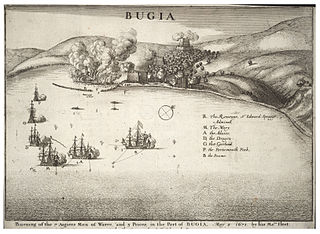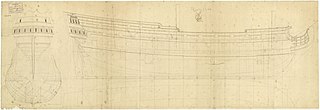
HMS Vanguard was a 90-gun second-rate ship of the line of the Royal Navy, built at Portsmouth Dockyard and launched in 1678.

HMS Cornwall was an 80-gun, third rate, ship of the line built for the Royal Navy in the 1690s. She served in the War of the Grand Alliance, and in her first year took part in the Battle of Barfleur and the action at La Hougue.

HMS Falkland was a 50-gun fourth-rate ship of the line of the Royal Navy, built by Holland of New Castle, New Hampshire, and purchased by the navy in 1696.

Advice was one of six 40-gun fourth-rate frigates, built for the Commonwealth of England under the 1650 Programme, she would be transferred to the navy of the Kingdom of England upon the Restoration of the monarchy in May 1660. During her time with the Commonwealth Navy she would fight in two major fleet engagements of the First Anglo-Dutch War, this being the Battle of Portland and the Battle of the Gabbard. After the Restoration she would be involved in the Second Anglo-Dutch War specifically the Battle of Lowestoft and the St James Day Battle. She would also be present at the attack on the Vile or better known as Holmes Bonfire. She would see action against the Algerines at the Battle of Bugia. During the Third Anglo-Dutch War she would do battle at the Battle of Solebay, The Battle of Schooneveld and the Battle of Texel. She would also do battle against the French at the Battle of Bantry Bay. She would see service in both the West and East Indies before being rebuilt at Woolwich.
HMS Assistance was one of six 40-gun fourth-rate frigates, built for the Commonwealth of England under the 1650 Programme, after the Restoration of the monarchy in 1660 she was incorporated into the navy of the Kingdom of England. During her time in the Commonwealth Navy she partook in the First Anglo-Dutch war being present in the battles of Kentish Knock, Portland and The Gabbard. In the Mediterranean she was present at the Battle of Santa Cruz and the bombardment of Porto Farina, In the Second Anglo-Dutch War she was involved in the Battle of Lowestoft, Battle of Vagen and the St James Day Fight. She did not participate in fleet actions after this. She spent the rest of her service life undergoing several rebuilds and plying the waters as a cruiser protecting British trade and projecting British sovereignty. After nearly 95 years of Service she was sunk as a break water at Sheerness at the end of 1745.

HMS Captain was a 70-gun third rate built at Woolwich Dockyard in 1677/78. After sitting in Ordinary for ten years she was in active commission for the War of the English Succession fighting at Beachy Head and Barfleur. She was in Ordinary until 1706 when she was rebuilt. She was in active commission for the last half of the War of Spanish Succession but fought in no major engagements. She was at the Battle of Passero I 1718. She was rebuilt in 1720/22. She made two forays in to the Baltic though the bulk of her late career was spent as guardship at Portsmouth. She was hulked in 1740 and finally broken in 1762.

HMS Hampton Court was a 70-gun third rate ship of the line of the Royal Navy, launched at Deptford Dockyard in 1678. Her initial commission was to move her to Chatham where she spent in the next ten years in Ordinary. She held an active commission for the War of the English Succession, participating in the Battles of Beachy Head and Barfleur. She was rebuilt at Blackwall in 1699/1701. During the War of Spanish Succession she served mainly in the Mediterranean. In 1707 she was taken by the French and incorporated into the French Navy for four years. She was sold to the Spanish in 1712. She was wrecked in Spanish service off the coast of Florida in a hurricane in 1715.

HMS Lenox was a 70-gun third rate built at Deptford Dockyard in 1677/78. She was in active commission for the War of English Succession fighting in the Battles of Beachy Head and Barfleur. She was rebuilt in 1699. Again in active commission for the War of Spanish Succession fighting in the Capture of Gibraltar and the Battle of Velez Malaga. She followed this with the Battle off Passero. She was rebuilt again in 1721. She was active in the War with Spain, capturing the Princesa then serving in Home Waters, the Mediterranean and finally the West Indies. She was in action off Havana in 1745. She returned home and was placed in Ordinary. She was finally sunk as a breakwater at Sheerness in 1756.
HMS Berwick was a 70-gun third rate ship of the line of the Royal Navy, built at Chatham Dockyard during 1677/1679. After completion she was placed in Ordinary for 10 years. She was commissioned for the War of the English Succession 1689-1697, participating in the battles of Beachy Head and Barfleur. She was rebuilt between 1697 and 1700. She was commissioned for the War of Spanish Succession 1702-1712, participating in the battles of Vigo Bay, Capture of Gibraltar and Velez Malaga. placed in Ordinary in 1712, she was converted to a hulk at Portsmouth in 1715 before being broken in 1742.
HMS Burford was a 70-gun third rate ship of the line built at Woolwich Dockyard in 1677/79 as part of the Thirty Ships Programme of 1677. She fought in the War of the English Succession, including the Battle of Barfleur, before being rebuilt at Deptford in 1699, remaining as a 70-gun third rate. During the War of Spanish Succession she was mostly in the Mediterranean fleet and fought at the capture of Gibraltar and the Battle of Málaga in 1704 before being extensively repaired between 1710 and 1712 at Portsmouth Dockyard. Burford served in the Baltic in 1715 and 1717 before returning to the Mediterranean to fight the Spanish at the Battle of Cape Passaro in 1718. She was wrecked on the Italian coast in a storm on 14 February 1719.
HMS Elizabeth was a 70-gun third rate built at Barnards Yard at Deptford Green by William and Robert Castle of Rotherhithe in 1678/80. She held an active commission during the War of the English Succession fighting in all three major engagements. She was rebuilt at Portsmouth between 1699 and 1704. She was captured by the French off the Scilly Islands in November 1704. She was in the French Navy until she was deleted in 1720.

HMS Essex was a 70-gun third rate built by Sir Henry Johnson of Blackwall in 1678/79. During the War of the English Succession she fought in the last major action. She was rebuilt in 1699/1700. During the War of Spanish Succession she fought at Vigo Bay, the Capture of Gibraltar and Velez Malaga. She also fought at the Battle off Passero in 1718. She was rebuilt again in 1736-40. She was in action off Toulon in 1744. She was active in the Channel and against French ports during the Seven Years War. She fought at Quiberon Bay in 1759. She was wrecked in Quiberon Bay in November 1759.

HMS Expedition was a 70-gun third-rate ship of the line built at Portsmouth Dockyard in 1677/79. She was in active commission during the War of the English Succession participating in the battles of Beachy Head and Barfleur. She was rebuilt in 1699. Again, for the War of Spanish Succession she was in commission for the operation at Cadiz then returned to England where she sat for two years. She was in the Mediterranean for the Battle of Marbella in 1705. She then went to the West Indies and fought in Wager's action off Cartagena in 1708. She was rebuilt in 1709-14 to the 1706 Establishment. She spent her time split between the Baltic and as guard ship at Portsmouth before being broken at Portsmouth in 1736. She was rebuilt in 1736/40 at Deptford Dockyard.

HMS Kent was a 70-gun third rate ship of the line built by Sir Henry Johnson of Blackwall in 1677/79. She served during the War of English Succession 1699 to 1697, participating in the Battle of Barfleur. She was rebuilt in 1697/99. She served during the War of Spanish Succession 1702 to 1712 and partook in the Battles of Vigo and Velez-Malaga. She partook in the Battle of Passaro then served during the short war with Spain, December 1718 to February 1720. She was rebuilt in 1722/26. She spent the next thirteen years as a guard ship at Portsmouth. In the 1740s she was off Cape Finisterre then in the West Indies. She returned home and was finally broken in 1744.

HMS Suffolk was a 70-gun third-rate ship of the line of the Royal Navy, built by contract of 20 February 1678 by Sir Henry Johnson at Blackwall. She participated in the War of the English Succession 1689 - 1697, in the Battles of Beachy Head and Barfleur. She was rebuilt in 1699. She was actively involved in the War of Spanish Succession 1702 - 1713. Her later career was as guard ship duties, deployments to the Baltic Sea and the West Indies. She was finally broken in 1765 after lying in Ordinary for almost twenty years.

HMS Kingston was a 60-gun fourth-rate ship of the line of the Royal Navy, built by Frame in Hull and launched on 13 March 1697. She had an eventful career, taking part in numerous engagements.
HMS Gloucester was a 60-gun fourth rate ship of the line built for the Royal Navy during the 1690s. She spent most of her career in the West Indies and participated in the 1701–15 War of the Spanish Succession. The ship was hulked in 1708 and broken up in 1731.
HMS Falmouth was a 50-gun fourth rate ship of the line built for Royal Navy in the 1690s. The ship participated in several battles during the Nine Years' War of 1688–97 and the War of the Spanish Succession (1701–1715), including the action of August 1702. She was captured by the French in 1704.
HMS Coventry was a 50-gun fourth rate ship of the line of the English Royal Navy, launched at Deptford Dockyard in 1695.
HMS Poole was a 32-gun fifth rate built by Joseph Nye & George Moore of East Cowes on the Isle of Wight in 1695/96. She spent the first part of her career on trade protection and counter piracy patrols. After 1719 she was converted to a fireship. She was finally sunk as a breakwater at Harwich in July 1737.











